
Exeter is a town in Rockingham County, New Hampshire, United States. Its population was 16,049 at the 2020 census, up from 14,306 at the 2010 census. Exeter was the county seat until 1997, when county offices were moved to neighboring Brentwood. Home to Phillips Exeter Academy, a private university-preparatory school, Exeter is situated where the Exeter River becomes the tidal Squamscott River.

Nicholas Gilman Jr. was an American Founding Father, a soldier in the Continental Army during the American Revolutionary War, a delegate to the Continental Congress, and a signer of the U.S. Constitution, representing New Hampshire. He was a member of the United States House of Representatives during the first four Congresses and served in the U.S. Senate from 1805 until his death in 1814. His brother John Taylor Gilman was also very active in New Hampshire politics, serving as Governor of New Hampshire for 14 years, as well as a principal benefactor of Phillips Exeter Academy. Their childhood home in Exeter is now the American Independence Museum.

The Wilson-Wodrow-Mytinger House is a complex of three structures, built between the 1740s and 1780s, in Romney, West Virginia. The clerk's office, dating from the 1780s, is the oldest surviving public office building in West Virginia. The kitchen building is the oldest remaining component of the Wilson-Wodrow-Mytinger House and the oldest building in Romney. Throughout its history, the Wilson-Wodrow-Mytinger House has been known as the Andrew Wodrow House, the Mytinger Family Home, and the Mytinger House.

The Fairbanks House in Dedham, Massachusetts is a historic house built ca. 1637, making it the oldest surviving timber-frame house in North America that has been verified by dendrochronology testing. Puritan settler Jonathan Fairbanks constructed the farm house for his wife Grace and their family. The house was occupied and then passed down through eight generations of the family until the early 20th century. Over several centuries the original portion was expanded as architectural styles changed and the family grew.

The Richard Jackson House is a historic house in Portsmouth, New Hampshire. Built in 1664 by Richard Jackson, it is the oldest wood-frame house in New Hampshire. It was designated a National Historic Landmark in 1968. It is now a historic house museum owned by Historic New England, and is open two Saturdays a month between June and October.
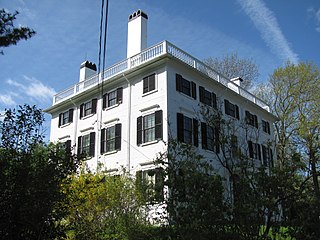
The Rundlet-May House is a historic house museum at 364 Middle Street in Portsmouth, New Hampshire, United States. Built in 1807, it is a well-preserved example of a high-end Federal style mansion, built for a wealthy merchant. The house is of particular significance due to the survival of early documentation related to its construction. It is now owned by Historic New England and open seasonally for tours. It was listed on the National Register of Historic Places in 1976.
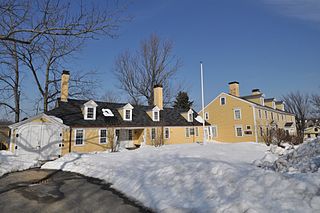
The Ladd-Gilman House, also known as Cincinnati Memorial Hall, is a historic house at 1 Governors Lane in Exeter, New Hampshire, United States. The home was built about 1721 by Nathaniel Ladd as one of the state's first brick houses, and was subsequently clapboarded three decades later. The home was purchased in 1747 by Daniel Gilman, a prominent Exeter merchant. It served as the state treasury during the American Revolutionary War when two members of the Gilman family, Col. Nicholas Gilman and his son John Taylor Gilman, later the state's governor, served as treasurers of the state. Also born in the house was Founding Father Nicholas Gilman, Jr., a signer of the United States Constitution and U.S. senator from New Hampshire.
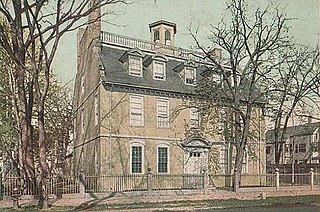
The Warner House, formerly known as the MacPheadris–Warner House, is a historic house museum at 150 Daniel Street in Portsmouth, New Hampshire, United States. Built 1716–1718, it is the oldest, urban brick house in northern New England, and is one of the finest early-Georgian brick houses in New England. It was declared a National Historic Landmark in 1960, and is listed on the National Register of Historic Places.

The Wentworth-Gardner House is a historic mid-Georgian house, located at 50 Mechanic Street in Portsmouth, New Hampshire, United States. The house is operated as a museum by the Wentworth-Gardner Historic House Association. It is one of the finest extant examples of high-style Georgian architecture in New England, and played a role in the architectural preservation movement of the early 20th century. It was declared a National Historic Landmark in 1968.
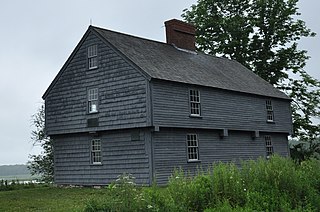
The McIntire Garrison House is a historic house on Cider Hill Road in York, Maine. Built c. 1707, it is an extremely rare well-preserved example of a New England colonial log garrison house, built by settlers for defense against Native American attacks. The house, possibly the oldest in the state, was designated a National Historic Landmark in 1968.

The American Independence Museum is a historic house museum located in Exeter, New Hampshire. Its 1-acre (0.40 ha) campus includes two buildings: the Ladd-Gilman House, a registered National Historic Landmark built in 1721 by Nathaniel Ladd, and the Folsom Tavern, listed on the New Hampshire State Register of Historic Places and built in 1775 by Colonel Samuel Folsom. The museum was opened in 1991 after a rare copy of the Declaration of Independence known as a Dunlap Broadside was found in the Ladd-Gilman house, 200 years after its arrival in Exeter. It is the centerpiece of the museum’s collection. The museum’s mission is “Connecting America’s Revolutionary past with the present.”

The Front Street Historic District in Exeter, New Hampshire, encompasses a portion of the town's historic center. The district extends from Swasey Pavilion, at the junction of Front and Water streets, southwesterly along Front Street to Gale Park, about five blocks. Front Street is one of Exeter's oldest roads, and is lined with a series of 18th and 19th-century civic, religious, and residential structures, many of which are well preserved. The district was listed on the National Register of Historic Places (NRHP) in 1973.

The Wilder-Holton House is a historic house museum at 226 Main Street in Lancaster, New Hampshire. Built in 1780, this two-story timber-frame house is believed to be the first two-story house built in the area, and to be the oldest surviving house in Coos County. It was listed on the National Register of Historic Places in 1975. The house is now owned by the Lancaster Historical Society, which operates it as a museum.
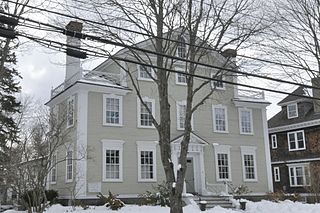
The Samuel Tenney House is an historic house at 65 High Street in Exeter, New Hampshire. This mansion was built circa 1800 as the primary residence of Samuel Tenney, a noted scholar, scientist, physician, American Revolutionary War surgeon, patriot, judge, and member of Congress, and his wife Tabitha Gilman Tenney, the noted early American author.

The Dudley House, also known as the Perry-Dudley House, is a historic house at 14 Front Street in Exeter, New Hampshire. Built about 1805, it is a prominent local example of Federal architecture, further notable for its occupation by two of the town's leading 19th-century doctors. The house was listed on the National Register of Historic Places in 1971. It now houses professional offices.

The Exeter Waterfront Commercial Historic District encompasses the historic commercial and residential waterfront areas of Exeter, New Hampshire. The district extends along the north side of Water Street, roughly from Main Street to Front Street, and then along both sides of Water and High streets to the latter's junction with Portsmouth Street. It also includes properties on Chestnut Street on the north side of the Squamscott River. This area was where the early settlement of Exeter took place in 1638, and soon developed as a shipbuilding center. The district was listed on the National Register of Historic Places in 1980. It was enlarged in 1986 to include the mill complex of the Exeter Manufacturing Company on Chestnut Street.

The Maj. John Gilman House is a historic house at 25 Cass Street in Exeter, New Hampshire, United States. Built in 1738, it is a well-preserved example of a Georgian gambrel-roof house, further notable for its association with the locally prominent Gilman family. It was listed on the National Register of Historic Places in 1988.

The Edward Sewall Garrison is a historic house at 16 Epping Road in Exeter, New Hampshire. With a construction history dating to 1676, it is one of New Hampshire's oldest buildings, and is a rare example of a formerly fortified garrison house in its original location. The house was listed on the National Register of Historic Places in 1980.
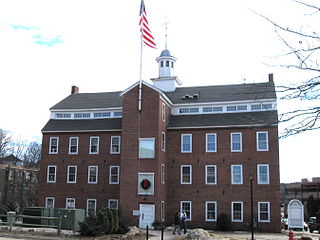
The Belknap-Sulloway Mill, now the Belknap Mill Museum, is a historic mill at 25 Beacon Street East in Laconia, New Hampshire, a city in Belknap County. Built sometime between 1823 and 1828, it is a rare well-preserved example of an early rural textile mill in New England, and was the business around which the city rose. The mill was in active use for the production of textiles until 1969, undergoing some modest alterations as well as the modernization of its power plant. It was opened as a museum in 1991, and was listed on the National Register of Historic Places in 1971.

The Congregational Church in Exeter is a parish of the United Church of Christ located on Front Street in Exeter, New Hampshire.























